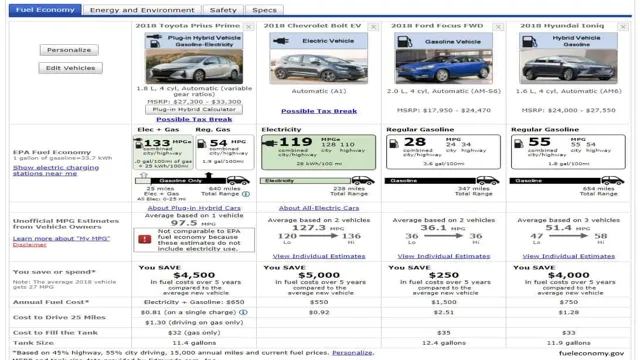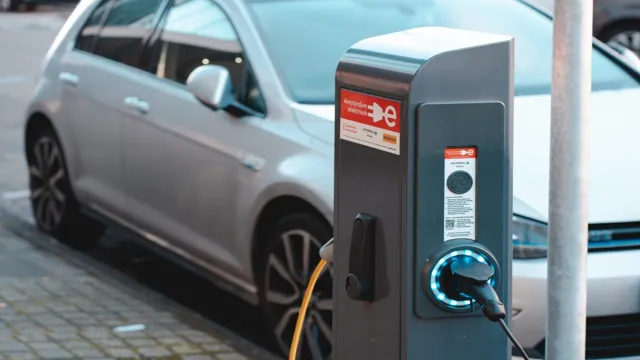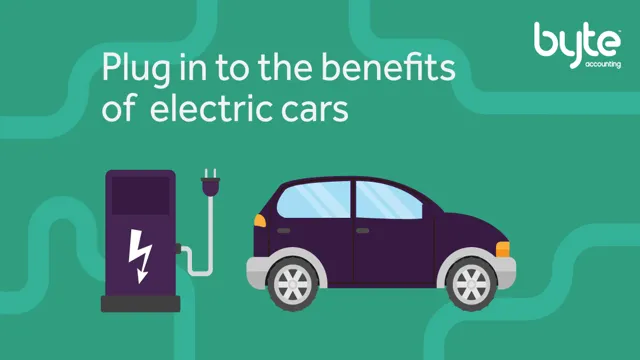Electrifying Savings: A Comprehensive Cost Benefit Analysis of Electric Cars
Electric cars are becoming increasingly popular, and for a good reason. They are environmentally friendly, quiet, and require less maintenance than traditional gasoline cars. But one crucial question that many people have when considering buying an electric car is, “Is it worth the cost?” After all, electric cars can cost more upfront than their gasoline counterparts.
This is where a cost-benefit analysis can come in handy. By comparing the costs of owning and operating an electric car with those of a gasoline car, you can determine if an electric car is a good investment for you. While the upfront cost may be higher, electric cars are often cheaper to operate and maintain in the long run.
There are several factors to consider when conducting a cost-benefit analysis, including the cost of fuel and electricity, maintenance, and tax incentives. Additionally, you will want to take into account the range of the electric car and charging infrastructure available in your area. Overall, electric cars can provide a cost-effective and environmentally friendly option for transportation.
By considering the cost-benefit analysis, you can make an informed decision about whether an electric car is the right choice for you.
Introduction
In recent years, there has been a growing interest in the use of electric cars as an alternative to traditional gasoline-powered vehicles. While their initial cost may be higher, there are numerous benefits to owning an electric car that make it a worthwhile investment in the long run. The cost-benefit analysis of electric cars takes into account factors such as fuel savings, maintenance costs, and tax incentives.
While it is true that electric cars may have a higher upfront cost, they make up for it in savings on fuel costs over time. Not only do electric cars require less maintenance than traditional gasoline-powered vehicles, but they also produce significantly less emissions and contribute to a cleaner environment. Additionally, there are a variety of tax incentives and rebates available for those who choose to invest in an electric car.
When it comes down to it, the cost-benefit analysis of electric cars makes it clear that they are a smart and sustainable investment for the future.
What is a Cost Benefit Analysis?
A cost-benefit analysis (CBA) is a structured process that helps businesses determine the feasibility of a particular project, program, or investment. It involves weighing the potential costs and benefits associated with undertaking a particular initiative, with the aim of maximizing benefits while minimizing costs. The CBA process typically involves identifying the objectives of the project, estimating all relevant costs and benefits (both financial and non-financial), and comparing them to determine the net impact.
By conducting a cost-benefit analysis, businesses can make informed decisions about whether or not to move forward with a particular initiative, and if so, how best to allocate resources to maximize potential benefits. Ultimately, a well-conducted CBA can help businesses save time, money, and other valuable resources in the long run by ensuring that they are making the most informed decisions possible.
Why Conduct a Cost Benefit Analysis for Electric Cars?
Electric cars have been gaining popularity in recent years as the public becomes increasingly aware of the impact of traditional gasoline-fueled vehicles on the environment. However, owning an electric car involves more than just purchasing a more eco-friendly vehicle. Before making the decision, it is important to conduct a cost-benefit analysis to determine if it is a financially feasible option.
This analysis takes into account the initial cost of purchasing an electric car, as well as the cost of charging and maintaining it. By weighing these costs against potential savings in fuel and maintenance expenses, drivers can determine if an electric car is the right choice for them. Conducting a cost-benefit analysis can help inform and guide individuals to make the best decision for their financial and environmental wellbeing.
Cost Savings
When it comes to electric cars, the advantages from a cost-benefit perspective are numerous. The initial cost may be higher than that of a conventional vehicle, but the long-term savings can be significant. Electric cars require less maintenance, as they have fewer mechanical parts and do not need oil changes.
The cost of charging an electric car is also much cheaper than that of fueling a gas-powered car. Moreover, there are several incentives available to electric car owners, such as tax credits or rebates. These incentives can offset the higher upfront costs.
Finally, electric cars depreciate slower than conventional cars, which means they hold their value better. In summary, a cost-benefit analysis of electric cars reveals that they offer significant savings in the long run despite a higher upfront cost.
Lower Fuel Costs
Lower fuel costs are a massive advantage of using renewable energy sources. Fossil fuels have dominated the energy industry for decades now, but with the rise of solar, wind, hydro, and geothermal energy, there are better alternatives available. Renewable energy sources such as wind turbines and solar panels do not need to be fueled or transported, with electricity generated directly from the source.
This means that the cost of energy production and transport is significantly reduced, leading to lower fuel costs. Additionally, once installed, renewable energy systems require minimal maintenance, further reducing costs. Investing in renewables today can lead to significant cost savings tomorrow.
Not only does this benefit individuals and businesses, but it also reduces our carbon footprint and helps preserve our planet for future generations.
Reduced Maintenance Costs
Reduced Maintenance Costs Are you looking for ways to save money on maintenance costs for your business? One solution is to invest in high-quality materials and equipment that require less upkeep and repairs. By doing so, you can avoid frequent breakdowns and malfunctions that can be costly to fix. Another option is to implement a preventive maintenance program that ensures your equipment is regularly serviced and checked for any issues.
This can help detect problems early on and prevent them from developing into more serious and expensive repairs. By prioritizing maintenance and investing in durable equipment, you can prolong the lifespan of your assets and save money in the long run. So, don’t wait until it’s too late – start taking proactive measures to reduce your maintenance costs today!
Tax Credits and Incentives
One of the biggest advantages of tax credits and incentives is the significant cost savings they offer businesses. By taking advantage of tax credits and incentives, businesses can reduce their tax burden and increase their bottom line. For example, the Work Opportunity Tax Credit (WOTC) offers employers a tax credit when they hire employees from targeted groups, such as veterans and individuals receiving government assistance.
This can amount to significant savings for businesses, especially if they are hiring a large number of employees. Additionally, tax incentives for investing in renewable energy or energy-efficient technology can also lead to cost savings over time by reducing energy costs. By taking advantage of tax credits and incentives, businesses can not only save money, but also invest in their long-term growth and competitiveness.
Environmental Benefits
Electric cars offer numerous environmental benefits that make them an attractive option for eco-conscious consumers. A cost-benefit analysis of electric cars shows that they are not only cheaper to operate in the long run, but they also emit significantly fewer greenhouse gases compared to traditional gasoline-powered vehicles. This reduced emissions output directly translates to cleaner air and a healthier environment, particularly in urban areas where air quality can be a major concern.
Additionally, electric cars do not require oil changes or emit tailpipe emissions, further reducing their impact on the environment. When powered by renewable energy sources, such as solar or wind power, electric cars have an even greater positive impact on the environment. By choosing to drive an electric car, consumers can make a meaningful contribution to protecting the planet and preserving its natural resources.
Reduced Greenhouse Gas Emissions
Reduced Greenhouse Gas Emissions One of the biggest advantages of reducing greenhouse gas emissions is the positive impact it has on the environment. By lessening the amount of greenhouse gases released into the atmosphere, we help to reduce the negative effects of global warming and climate change. This means less extreme weather events, such as hurricanes, floods, and droughts, and less damage to ecosystems.
Additionally, by reducing our reliance on fossil fuels, we can decrease the amount of pollution in our air and water, leading to cleaner, healthier living conditions for us and for wildlife. For instance, let’s take a moment to imagine a world where carbon emissions have been significantly reduced. A world where the air is cleaner and the skies are bluer, where the oceans are healthier and the forests are thriving.
In this world, our energy would come from clean, renewable sources like solar and wind power, and we would be able to enjoy the benefits of a more sustainable and eco-friendly way of life. By taking small steps towards reducing our carbon footprint, such as biking instead of driving or using energy-efficient appliances, we can all do our part to contribute to a cleaner, greener future. In conclusion, reducing greenhouse gas emissions is vital to protecting our planet’s delicate ecosystems and ensuring a healthier, more sustainable future for generations to come.
By embracing clean energy sources and adopting eco-friendly practices in our daily lives, we can all play a role in reducing our carbon footprint and working towards a brighter, cleaner future. So let’s take action and do our part to protect the environment and create a more sustainable world.
Improved Air Quality
Improved air quality is one of the significant environmental benefits that come with reducing pollution. The benefits of improved air quality are numerous and range from fewer respiratory illnesses to the reduction in greenhouse gases. Air pollution can cause many respiratory issues and can aggravate pre-existing conditions like asthma.
However, reducing pollution levels can significantly reduce such cases, including cardiovascular disease. Studies have shown that efforts to lower pollution levels in major cities have led to a marked decrease in the number of hospital admissions and premature deaths. Additionally reducing air pollution can help reduce global warming.
With fewer harmful greenhouse gases produced, the ozone layer will remain stable while also slowing down the progression of climate change. By making conscious choices like using public transportation or carpooling, we can all contribute to a cleaner environment and better air quality.
Reduced Noise Pollution
Reduced noise pollution benefits the environment in many ways. Noise pollution refers to excessive, unwanted, or disturbing sound that can have harmful effects on health and the environment. With the adoption of new technology and policies, noise pollution is increasingly being mitigated.
Reduced noise pollution has a positive impact on wildlife, reducing the risk of disorientation and habitat disruption. Human health also benefits from reduced noise pollution since prolonged exposure to loud noise can cause hearing loss, chronic stress, and cardiovascular disease. Additionally, reduced noise pollution helps to create a calm and peaceful environment for individuals.
Conservationists hope to continue to work on ways to reduce noise pollution to improve the health and well-being of both humans and animals.
Potential Drawbacks
When it comes to the cost benefit analysis of electric cars, there are some potential drawbacks to consider. Firstly, the initial purchase price of an electric car can be much higher than that of a traditional petrol or diesel vehicle. However, this can often be offset over time by the lower running costs and maintenance of an electric car.
Additionally, there can sometimes be limited options for charging stations, which could be problematic for longer journeys. Finally, the production process and disposal of batteries used in electric cars can have negative environmental impacts if not managed properly. It’s important to weigh these potential drawbacks against the benefits of electric cars, such as reduced emissions and lower running costs, to make an informed decision on whether an electric car would be a good fit for your lifestyle and budget.
Higher Upfront Costs
While investing in renewable energy sources may seem like a prudent decision for the future, there are some potential drawbacks that should not be overlooked. One of the main concerns is the higher upfront costs associated with renewable energy technologies. While renewables may save money on energy bills in the long term, the initial cost of installing solar panels, wind turbines, or other alternative energy systems can be prohibitive for many homeowners and businesses.
However, it is important to note that there are various financing options available for those interested in making the switch to renewable energy, including incentives, rebates, and financing programs. By weighing the upfront costs against the long-term benefits, it is possible to make informed decisions about renewable energy investments that can help reduce carbon emissions and save on energy costs over time.
Limited Distance Range
While electric vehicles continue to gain popularity, there are some potential drawbacks that need to be considered. One such drawback is the limited range of a single charge. While the range has improved in recent years, it is still a concern for many drivers.
Depending on the make and model, electric vehicles can typically travel 100-300 miles on a single charge, which may not be sufficient for longer trips or commutes. While there are charging stations available, they can sometimes be difficult to find or may not be conveniently located for drivers. However, with advances in technology and infrastructure, the range of electric vehicles is likely to improve in the coming years.
As a consumer, it is important to weigh the benefits and drawbacks of electric vehicles before making a purchase decision.
Limited Charging Infrastructure
One of the potential drawbacks of electric vehicles is the limited charging infrastructure currently available. Although the number of charging stations is increasing, it is still significantly less than the number of gas stations. This can make it difficult for drivers to find a charging station when they need one, especially during long road trips.
Additionally, some people may not have access to a charging station at home or work, making it more inconvenient to keep their vehicle charged. However, it’s important to note that advancements in technology and government incentives are driving the development of more charging stations, which will make owning an electric vehicle more feasible for a larger group of people.
Conclusion
In conclusion, the cost benefit analysis of electric cars is clear – they may have a higher initial cost, but the long-term benefits outweigh this expense. With lower fuel and maintenance costs, as well as a positive impact on the environment, electric cars are a smart investment for those looking to save money and reduce their carbon footprint. Plus, with advances in technology, the driving experience of electric cars is becoming just as fun and exciting as their gas-guzzling counterparts.
So, why go for a traditional car when you can choose an electric one and ride the wave of a cleaner, brighter future?”
Are Electric Cars Worth It?
When it comes to electric cars, there are some potential drawbacks to consider. One of the biggest is the limited range that some models offer. While there are more and more EVs hitting the market with longer ranges, some may still struggle to meet the needs of certain drivers, especially those who travel long distances on a regular basis.
Additionally, charging infrastructure can be limited in some areas, which can make it difficult for drivers to find convenient places to charge up. Some people also have concerns about the environmental impact of producing the batteries used in EVs. However, it’s important to remember that these drawbacks are gradually being addressed as EV technology improves and becomes more widely adopted.
Overall, while electric cars may not be the best fit for every driver at the moment, the benefits they offer, such as lower operating costs and reduced emissions, make them a worthwhile option to consider.
FAQs
What is a cost benefit analysis of electric cars?
A cost benefit analysis of electric cars is an evaluation that compares the cost of owning and operating an electric car to the cost of owning and operating a gas-powered car, taking into account factors such as fuel, maintenance, and environmental impact.
What are the advantages of electric cars in a cost benefit analysis?
The advantages of electric cars in a cost benefit analysis include lower fuel costs, reduced maintenance costs, and potential tax incentives or rebates. Additionally, electric cars have a lower environmental impact than gas-powered cars.
What are the potential drawbacks of electric cars in a cost benefit analysis?
The potential drawbacks of electric cars in a cost benefit analysis include higher upfront costs, limited range compared to gas-powered cars, and longer charging times. Additionally, the availability of charging infrastructure may vary depending on location.
How can a cost benefit analysis be used to determine if an electric car is a good investment?
A cost benefit analysis can be used to determine if an electric car is a good investment by calculating the total cost of ownership and comparing it to the cost of owning a gas-powered car. This analysis should take into account the individual’s driving habits, location, and available charging infrastructure.







